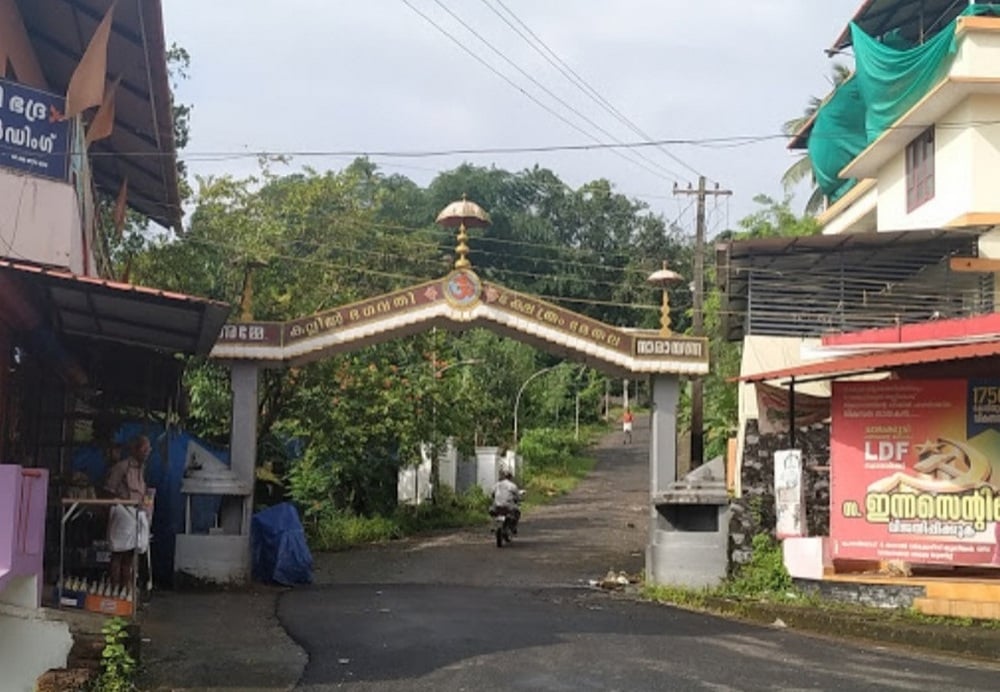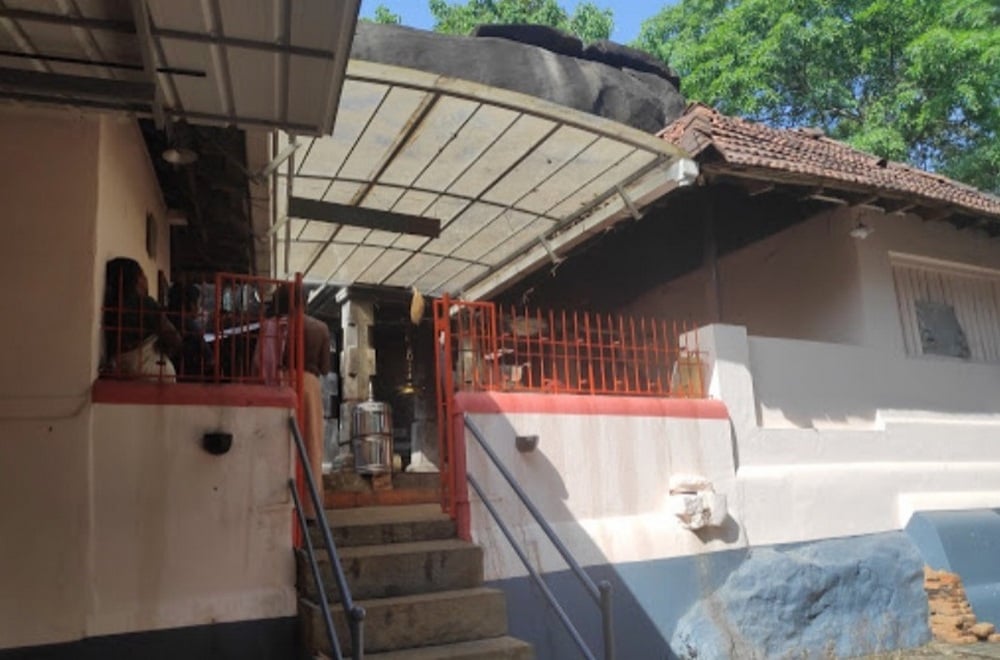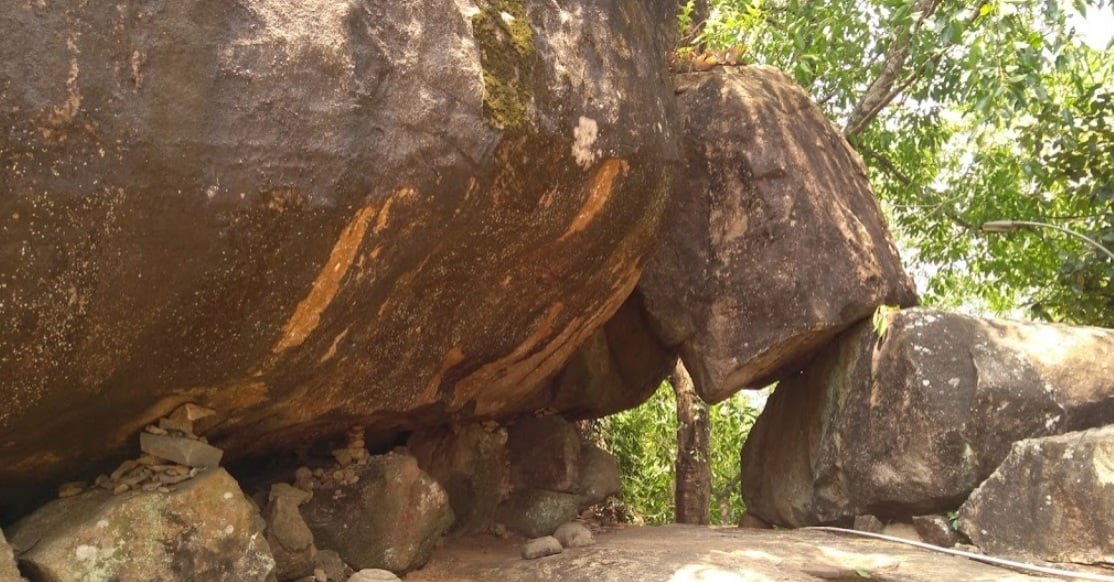Kallil Temple is a historic Hindu-Jain temple located in Methala, near Perumbavoor in Ernakulam district, Kerala. The name "Kallil" means "in stone," symbolizing its unique rock-cut architecture.

Believed to date back to over 5,000 years, the temple is carved from a massive rock and is accessible by climbing 69 steps. It is one of Kerala's most ancient temples and is now a protected monument under the Kerala State Department of Archaeology. Situated on a 28-acre plot, the temple was originally owned and managed by the Kallil Pisharody family.
The administrative control was briefly transferred to 'Chenkottukonam Sree Ramadasashramam,' but was later retrieved due to disputes with the local community. The temple is located 10 km from Perumbavoor and 4 km from Odakali on the Perumbavoor-Kothamangalam route. This temple, where history and legend intertwine, holds a special place in Kerala’s spiritual heritage. The Kallil Bhagavathi Temple, marked on Perumbavoor’s temple map, stands as a testament to Kerala’s rich and ancient traditions, with stories and myths that continue to captivate devotees and visitors alike. It is believed that Kallil Temple was originally a Jain temple in its early days.
The presiding deity, now worshipped as Bhagavathi, is believed to be Padmavati, the Yakshini of Jainism. The transformation from a Jain temple to a Bhagavathi temple is thought to have occurred in the ninth century. A local legend speaks of a mysterious woman who was once seen playing with stones in the forest. When people approached, she disappeared, hiding in a cave along with the stones. It is believed that this woman was none other than Goddess Bhagavathi. According to legend, the stone that ascended while the goddess played became the temple’s roof, while another descended to form its seat. Even today, the massive rock that serves as the temple’s roof remains suspended without touching the ground. It is said that even if 15 elephants try to move it, the rock remains immovable.
Two significant vows observed at the temple are the "Stone Vow" and the "Broom Vow." The Broom Vow is observed by women seeking hair growth and by men wishing to resolve family issues. Devotees offer a broom made of wool, ensuring that it has not come into contact with iron, as part of their prayer. The Stone Vow is associated with the completion of unfinished house construction. If devotees bring two or three stones from their incomplete house to the temple and offer prayers, it is believed that their construction work will be completed within a year. Many people return to the temple after their wishes are fulfilled to express gratitude.
Kallil Temple, also known as the Kallil Cave Temple, is unique as the goddess is enshrined within a natural stone cave. Due to its cave structure, devotees cannot circumambulate the shrine in the usual manner. Instead, the ritual of circumambulation is completed by bowing to the surrounding rock. There is strong evidence that the temple was originally a Jain place of worship. The rock-carved idols of Parshvanath (23rd Tirthankara) and Vardhaman Mahavira (24th Tirthankara) are still present, though they have since been revered as Lord Shiva and Lord Vishnu.
The temple's major festival is celebrated on the Karthika day in the Malayalam month of Vrishchikam (Scorpio), lasting for eight days. In earlier times, temple visits were restricted after the noon pooja due to the difficulty of returning for the evening rituals. However, while the temple still closes after the noon pooja, it now reopens in the evening for devotional rituals and the Athazha pooja.
കല്ലിൽ ഭഗവതി ക്ഷേത്രം
എറണാകുളം ജില്ലയിലെ പെരുമ്പാവൂരിന് സമീപമുള്ള മേത്തല ഗ്രാമത്തിലാണ് കല്ലിൽ ഭഗവതി ക്ഷേത്രം സ്ഥിതിചെയ്യുന്നത്. ഒമ്പതാം നൂറ്റാണ്ടിൽ സ്ഥാപിതമായ കേരളത്തിലെ പ്രശസ്ത ജൈനക്ഷേത്രമായിരുന്ന ഇത്, പിന്നീട് ഭഗവതിക്ഷേത്രമായി മാറിയെന്നാണ് വിശ്വാസം. കേരളത്തിലെ ഏറ്റവും പുരാതനമായ ഹിന്ദു ക്ഷേത്രങ്ങളിൽ ഒന്നായ കല്ലിൽ ക്ഷേത്രം 28 ഏക്കറിലധികം വിസ്തീർണ്ണമുള്ള കാടിനകത്താണ് സ്ഥിതി ചെയ്യുന്നത്. ഒരു വലിയ പാറയുടെ മുകളിൽ പണിത ഈ ക്ഷേത്രത്തിലേക്ക് പ്രവേശിക്കാൻ 120 പടികൾ കയറേണ്ടതുണ്ടു.
പെരുമ്പാവൂരിൽ നിന്ന് 10 കിലോമീറ്റർ അകലെയാണ് ക്ഷേത്രം. മുൻകാലത്ത് കല്ലിൽ പിഷാരോടി കുടുംബത്തിന്റെ ഉടമസ്ഥതയിലുണ്ടായിരുന്ന ക്ഷേത്രം, ഇപ്പോൾ പിഷാരത്ത് ദേവസ്വത്തിന്റെ നിയന്ത്രണത്തിലാണ്. 69 പടികൾ കയറിയാൽ ക്ഷേത്രത്തിലെത്താം. ഓടക്കാലിയിലുടെ ആലുവ-മൂന്നാർ റോഡിലൂടെയും പെരുമ്പാവൂരിൽ നിന്ന് 10 കിലോമീറ്റർ സഞ്ചരിച്ചും ക്ഷേത്രത്തിൽ എത്താവുന്നതാണ്.
ഈ ക്ഷേത്രം പുരാവസ്തു വകുപ്പിന്റെ സംരക്ഷണത്തിലായതോടെ കേരളത്തിലെ സംരക്ഷിത സ്മാരകങ്ങളിൽ ഒന്നായി പരിഗണിക്കപ്പെടുന്നു.
ഒരിടത്തേയ്ക്ക് ആധികാരിക അധികാരം ചെങ്കോട്ടുകോണം ശ്രീരാമദാസാശ്രമത്തിന് കൈമാറിയിരുന്നുവെങ്കിലും, നാട്ടുകാരും ആശ്രമ ഭരണസമിതിയും തമ്മിലുള്ള ആശയവ്യത്യാസങ്ങളെ തുടർന്ന് നിയന്ത്രണം തിരികെ പുനഃസ്ഥാപിക്കപ്പെട്ടു.
"കല്ല്" എന്ന പദം ആദിദ്രാവിഡ ഭാഷയിൽ നിന്ന് ഉത്ഭവിച്ചതാണ്. കല്ല് + ഇൽ = കല്ലിൽ എന്ന രൂപത്തിൽ മാറി, ഗുഹാക്ഷേത്രത്തിനെ സൂചിപ്പിക്കുന്ന പദമായി പ്രസിദ്ധമായി. കുഴിക്കുക, മാളം ഉണ്ടാക്കുക എന്നർത്ഥത്തിൽ ഉപയോഗിച്ചിരുന്ന ഈ പദം കല്ലിൽ ഭഗവതി ക്ഷേത്രത്തിൻറെ ഗുഹാസ്വഭാവത്തെ പ്രകടിപ്പിക്കുന്നു.
ക്ഷേത്ര കവാടം കടന്നാൽ പാറകളാൽ നിറഞ്ഞ വഴിയും ചെറുകാടുകളും കാണാം. മുകളിലേക്ക് കയറുമ്പോൾ പാറക്കല്ലുകൾ കൂടുതൽ ദൃശ്യമായിത്തീരും. ക്ഷേത്രത്തിലെ ശ്രീകോവിലിലേക്കുള്ള 120 പടികളും കരിങ്കല്ലിൽ തീർത്തതാണ്. ആനപ്പന്തലിലെ കരിങ്കൽത്തൂണുകളും അതിശയിപ്പിക്കും. പ്രദക്ഷിണവഴിയും ശ്രീകോവിലിന്റെ മുന്നിലുള്ള നിലവും മുഴുവനായും കല്ലിൻ്റെ പാളികളാലാണ് നിർമ്മിച്ചത്.ശ്രീകോവിലിനു മുമ്പിലുള്ള നമസ്കാരമണ്ഡപം മേൽക്കൂരയടക്കം മുഴുവനായും കരിങ്കല്ലിൽ നിർമിച്ചിരിക്കുന്നു.
ഭഗവതി ഇരുന്നരുളുന്ന ശ്രീകോവിൽ ഒരു വൻ പാറയിൽ രൂപപ്പെട്ട ഗുഹയിലാണ്. ഗുഹാക്ഷേത്രമായതിനാൽ പരിക്രമണം നടത്തുമ്പോൾ പതിവ് ക്ഷേത്രങ്ങളിലേതുപോലെ ശ്രീകോവിലിനു ചുറ്റുമായി നടന്ന് ദർശനം നടത്താൻ സാധിക്കില്ല. ഭക്തർ ശ്രീകോവിലിനെയും അതിന് ആശ്രയിച്ചിരിക്കുന്ന പാറകളെയും ചുറ്റിയാണ് പ്രദക്ഷിണം വയ്ക്കുന്നത്.
പ്രദക്ഷിണ വഴികളിൽ പാറകൾക്ക് ഇടയിൽ രൂപപ്പെട്ട ചെറിയ ഗുഹകളും കാലങ്ങളായി ദേവിക്ക് പാദസേവ ചെയ്യുന്ന വേരുകളുമാണ് ശ്രദ്ധേയമായ കാഴ്ചകൾ.
അക്ഷരാർത്ഥത്തിൽ 'കല്ലിൽ' അർപ്പിതമായ ദേവിയെയാണ് ഭക്തർ ഇവിടെ അനുഭവപ്പെടുന്നതും ദർശിക്കുന്നതുമാണ്. കല്ലിൽ ക്ഷേത്രം, ആര്യാധിപത്യകാലത്തിന് മുമ്പ് പ്രശസ്തമായ ഒരു ജൈന ഗുഹാക്ഷേത്രമായിരുന്നു. പിന്നീട് ബ്രാഹ്മണാധിപത്യകാലത്ത് പ്രതിഷ്ഠയും സങ്കൽപ്പങ്ങളും ബ്രാഹ്മണീയ രീതിയിൽ മാറ്റപ്പെട്ടു. ഗുഹാക്ഷേത്രങ്ങളുടെ ഉത്ഭവം ജൈനമതം ശക്തമായിരുന്ന കാലത്താണ്.
ക്ഷേത്രത്തിലെ പ്രധാന പ്രതിഷ്ഠ ദുർഗ്ഗാദേവിയാണ്. ഒരു വലിയ പാറ തുരന്നുണ്ടാക്കിയ ഗുഹയിലാണ് ഭഗവതിയുടെ പ്രതിഷ്ഠ. പഞ്ചലോഹം കവചം കൊണ്ടാണ് ദേവിയുടെ വിഗ്രഹം പൊതിഞ്ഞിരിക്കുന്നത്.
പ്രഥമഘട്ടത്തിൽ ജൈനമതത്തിലെ യക്ഷിയായ പദ്മാവതിയാണ് ഈ വിഗ്രഹം എന്ന് കരുതപ്പെടുന്നു.
ക്ഷേത്രം സ്ഥിതിചെയ്യുന്ന പാറമലയുടെ മുകളിലായി ബ്രഹ്മാവിന്റെ വിഗ്രഹം കൊത്തിയുണ്ടാക്കിയിരിക്കുന്നു. ബ്രഹ്മാവിനൊപ്പം ശിവനും വിഷ്ണുവും പ്രതിഷ്ഠിതരായി നിലകൊള്ളുന്ന സങ്കല്പമാണ് ഇവിടെ പ്രചാരത്തിലുള്ളത്. അതിനാൽ ശിവനും വിഷ്ണുവിനുമൊപ്പം ബ്രഹ്മാവിനും ഈ ക്ഷേത്രത്തിൽ പൂജകൾ അർപ്പിക്കുന്നു. ചരിത്രപരമായി ഇവ പാർശ്വനാഥന്റെയും മഹാവീരന്റെയും വിഗ്രഹങ്ങളായിരുന്നുവെന്നാണ് അനുമാനം.
ക്ഷേത്രത്തിൽ ഗണപതി, ശാസ്താവ്, കരിനാഗയക്ഷി എന്നിവരും ഉപദേവതകളായി സാന്നിധ്യം പുലർത്തുന്നു.
വലിയമ്പലത്തിനു പുറത്തായി വടക്കുകിഴക്കൻ മൂലയിൽ പടിഞ്ഞാറോട്ടു ദർശനമായി ഒമ്പത് പ്രതിഷ്ഠകളാണ് ഉള്ളത്. അടുത്ത കാലം വരെയും ഉച്ചപൂജയ്ക്ക് ശേഷം പൂജകൾ അവസാനിച്ച് മദ്ധ്യാഹ്നത്തോടെ നടയടയ്ക്കുന്ന പതിവായിരുന്നു. കാടിനടുവിലുള്ള ഈ ഗുഹാക്ഷേത്രത്തിൽ മേൽശാന്തിക്ക് രാത്രികാലങ്ങളിൽ പൂജകൾ നിർവഹിക്കാൻ ഉണ്ടായിരുന്ന ബുദ്ധിമുട്ട് പരിഗണിച്ചായിരിക്കാം ഇത്.
അന്നാളുകളിൽ സന്ധ്യാപൂജകൾ കല്ലിൽ ഷാരത്തിൽ തന്നെ നടത്തി വരുകയായിരുന്നു.
എന്നാൽ, ഏതാനും വർഷങ്ങളായി ഉച്ചപൂജയ്ക്ക് ശേഷം നടയടയ്ക്കുന്ന ക്ഷേത്രം സന്ധ്യയോടെ ദീപാരാധനയ്ക്കായി വീണ്ടും തുറക്കുന്നു. അത്താഴപൂജയ്ക്കു ശേഷം 7:30 ഓടെ പൂജകൾ അവസാനിക്കുകയും നടയടയ്ക്കുകയും ചെയ്യുന്നു. ഈ പദ്ധതി നിലവിൽ വരുന്നതിനു മുമ്പ് വൃശ്ചികമാസത്തിലെ കാർത്തിക ദിനമായ തൃക്കാർത്തിക മഹോത്സവ നാളുകളിൽ മാത്രമേ ദീപാരാധന ഉൾപ്പെട്ട സായാഹ്നപൂജകൾ പതിവുണ്ടായിരുന്നുള്ളൂ.
ക്ഷേത്രത്തിലെ തന്ത്രാവകാശം നെടുമ്പുള്ളി തരണനല്ലൂർ മനയ്ക്കാണ്. നേരത്തേ കല്ലിൽ പിഷാരോടി കുടുംബത്തിന്റേതായിരുന്ന ഈ ക്ഷേത്രഭരണം പിന്നീട് തിരുവനന്തപുരത്തുള്ള ചെങ്കോട്ടകോണം ശ്രീരാമദാസാശ്രമം ഏറ്റെടുക്കുകയായിരുന്നു. എന്നാൽ പിന്നീട് പിഷാരത്ത് ദേവസ്വം വീണ്ടും ക്ഷേത്രഭരണം ഏറ്റെടുത്തു. പ്രതിവർഷം വൃശ്ചികമാസത്തിലെ കാർത്തിക നാളിൽ ആരംഭിച്ച് എട്ടുദിവസം നീണ്ടുനിൽക്കുന്ന ഉത്സവം ക്ഷേത്രത്തിലെ പ്രധാന ആഘോഷമാണ്. നവംബർ-ഡിസംബർ മാസങ്ങളിൽ ഈ മഹോത്സവം ആഘോഷിക്കപ്പെടുന്നു.
ഉത്സവത്തിനിടെ, ക്ഷേത്രത്തിലെ പ്രതിഷ്ഠയെ ഒരു പിടിയാനപ്പുറത്തിരുത്തി ക്ഷേത്രപ്രദക്ഷിണം നടത്തുന്നതും ഈ ക്ഷേത്രത്തിന് സവിശേഷമായ ആചാരങ്ങളിലൊന്നാണ്.
കല്ലിൽ പിഷാരോടി കുടുംബത്തിന്റെ ജൈന പിന്മുറക്കാരായ ഒല്ലി സമുദായാംഗങ്ങൾ ഇപ്പോഴും ഇവിടെ ജൈന ദേവന്മാരായ പാർശ്വനാഥൻ, മഹാവീരൻ, പത്മാവതി ദേവി എന്നിവരെ ആരാധിച്ച് വരുന്നു. ഇത് ജൈനമതത്തിന്റെ ചിന്താഗതിയെയും ക്ഷേത്രത്തിന്റെ പൈതൃകത്തെയും ഒരുപോലെ പ്രതിഫലിപ്പിക്കുന്നതാണ്.
Address:
Pulluvazhi Kallil Rd,
Methala,
Perumbavoor, Kerala 683545



